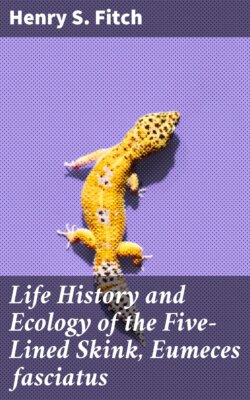Читать книгу Life History and Ecology of the Five-Lined Skink, Eumeces fasciatus - Henry S. Fitch - Страница 4
На сайте Литреса книга снята с продажи.
Methods
ОглавлениеTable of Contents
Skinks were obtained by active search; rocks and boulders were lifted up and the skinks thus exposed were seized by hand before they had time to escape. This method was effective when the skinks were using rocks for shelter and when temperatures were low enough so that they were slow and sluggish, but in hot weather the skinks were so quick and active that those exposed usually escaped. Usually skinks could be obtained much more easily by trapping. At the pond rock pile (Fig. 26), for instance, shelter was so readily available that the skinks could seldom be caught by hand. Gallon cans buried with the tops open flush with the surface of the ground served as pitfalls and were effective when they were carefully placed, at the bases of rock ledges or logs or stumps, where the skinks were most likely to fall into them. Most of the skinks recorded at the rock pile were caught by this method, and sometimes several were caught together in the same pitfall. Ordinarily each pitfall was covered with a large flat rock, propped against a nearby object to leave ample space for the skink to enter beneath it. The rocks provided protection from direct sunlight, from rain, and from predators. Still another method of catching skinks was with wire screen funnel traps (Fitch 1951:77). These funnel traps were of different sizes, and were made of different kinds of wire mesh. They were set for reptiles that were mostly larger than five-lined skinks, and those having quarter-inch wire mesh permitted many of the immature skinks to escape. Most of these funnel traps were from about one foot long and five inches in diameter, to about twice these dimensions, with funnel openings about 1.5 inches in diameter. Some made of 1⁄8 inch wire mesh, six or seven inches long, and three or four inches in diameter, with funnel openings only a little larger than the body diameter of an adult skink, were found to be suitable for skinks of all sizes, and were used successfully at the pond rock pile. Most of the skinks trapped were adult males, and they were taken chiefly in May. The funnel traps were generally placed at the edges of rock outcrops, boulders or logs, where skinks were likely to be intercepted in their usual travel routes. Each method of collecting skinks resulted in occasional mortality to them but most losses were in those caught in funnel traps. In these traps they sustained rapid loss of moisture, and were usually somewhat desiccated. Two or more adult males were often caught together, and in most of these instances the first one caught probably served as bait attracting another and arousing his pugnacious interest. Injuries were frequent, and some deaths occurred because in the close confines of a trap the loser in a fight was unable to escape further attacks.
Most of the skinks caught were examined, and released within a few minutes. Snout-vent length was measured by holding the skink against a rigid transparent plastic millimeter ruler and exerting a slight pull on each end of the lizard until it tired and relaxed its muscles, eliminating bends and kinks. Even with such precaution, precise measurements could not be obtained and the readings often varied a millimeter or more for the same skink measured two or more times on the same day. Tail length was similarly recorded with separate readings for the original and regenerated portions. Also recorded were sex (when discernible), color and pattern, breeding data, injuries, general condition, and sometimes temperature. Many of the skinks were brought to the laboratory, and were weighed to the nearest tenth of a gram.
Occasional trips were made to localities away from the Reservation to collect skinks. Some of those obtained were kept under observation in terraria where their behavior was studied. Most were preserved and were used for data on habitat preferences, seasonal changes in the gonads, size group, stomach contents, and various other items of information.
